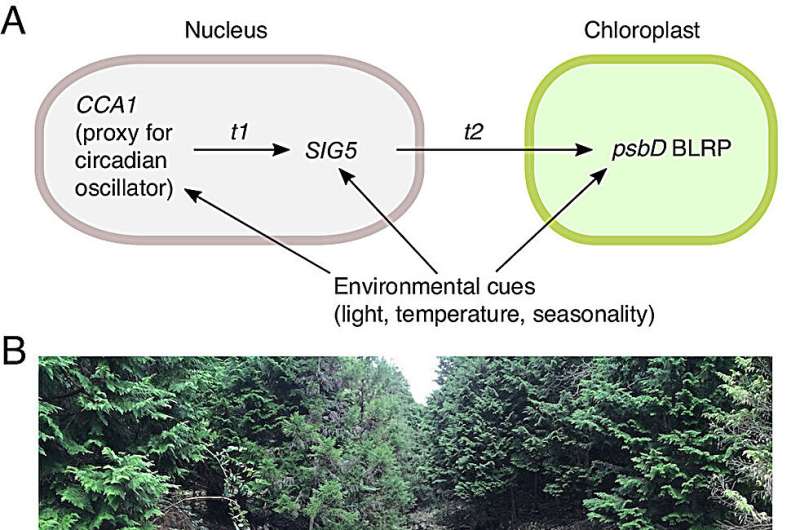This article has been reviewed according to Science X's editorial process and policies. Editors have highlighted the following attributes while ensuring the content's credibility:
fact-checked
peer-reviewed publication
trusted source
proofread
Innovative field experiments shed light on biological clocks in nature

Much of what we know about plant circadian rhythms is the result of laboratory experiments where inputs such as light and temperature can be tightly controlled.
Less is known about how these biological timing mechanisms operate in the more unpredictable natural world where they evolved to align living things to daily and seasonal cycles.
A pioneering collaborative study between UK and Japanese researchers has helped redress the balance with a series of innovative field experiments that show how plants combine clock signals with environmental cues under naturally fluctuating conditions.
This research team from the John Innes Center, Kyoto University, and The Sainsbury Laboratory, Cambridge, have produced statistical models based on these field-based studies that could help us predict how plants, major crops among them, might respond to future temperatures.
"Our research highlights the value of international collaboration in cross-disciplinary scientific progress," said senior author Professor Antony Dodd, a group leader at the John Innes Center. "It is fascinating to see how processes we have identified in the lab also work to influence plants under natural conditions."
Professor Hiroshi Kudoh from Kyoto University said, "Any living system has evolved in the context of its natural habitat. A great deal of work lies ahead to assess the function of genetic systems under natural conditions. This study was designed as one of the beginnings of such an endeavor."
A previous study by the group of Professor Dodd identified a genetic pathway under the control of the biological clock that operates to protect photosynthesizing plants from cell damage in bright cold conditions.
In this present study, "Circadian and environmental signal integration in a natural population of Arabidopsis," which appears in PNAS, the research team set out to identify this same mechanism in nature, drawing on a strong body of "in natura" research led by Professor Hiroshi Kudoh.
In two field studies around the March and September equinoxes, they analyzed a natural population of Arabidopsis halleri plants on a rural Japanese field site.
They monitored how gene expression in the plants changed over 24-hour cycles as light and temperature varied.
Experiments involved extracting RNA from plants every two hours, freezing these samples and taking them back to the lab for analysis so that they could track gene expression levels in tissues.

The team also built equipment that enabled them to manipulate the temperatures around plants. This enabled them to recapitulate the conditions they produced in the lab in their previous study.
Plants are highly sensitive to red and blue light; so, to avoid influencing experimental findings, researchers wore green filters over their head torches which effectively meant that they were invisible to plants during nocturnal visits.
"It is surprising how difficult it is to identify green plants with a green head torch in the middle of the night, in pouring rain," remarked Professor Dodd.
Using the information collected from samples, the researchers observed patterns in the expression of genes in the previously discovered genetic pathway that integrates information from the plant circadian clock with light and temperature signals.
The data collected showed that the plants in wild populations showed the same sensitivity to cold and bright dawn conditions previously observed in laboratory experiments.
Based on this information, the team developed statistical models which accurately predict how gene expression activity under control of the circadian clock will respond to environmental signals over a day in nature.
"We believe this is the first time anyone has modeled a whole circadian clock signaling pathway in plants growing outdoors," said Professor Dodd.
"If we can produce models that can accurately predict gene expression in relation to environmental conditions, then it may be possible to breed plants that are able to adapt to future climate conditions."
Dr. Haruki Nishio from Shiga University, joint first author on the study, said, "The flexibility of Bayesian time-series modeling allowed us to disentangle complex signal integration in natural environments. This approach has proven particularly effective for studies conducted in intricate environmental settings."
This study examined plant responses at the level of gene expression. The next stage for this research is to apply the statistical models produced in this study to functions of plant physiology such as the rate of photosynthesis or adaptation to temperature.
Dr. Dora Cano-Ramirez, a circadian clock researcher now at the Sainsbury Laboratory Cambridge University and joint first author of the research, said, "The circadian clock regulates many key plant processes as shown in studies under laboratory settings. However, we have not known the extent to which these processes translate to field conditions until now."
"Understanding how circadian-regulated processes are aligned with a fluctuating environment by modeling this signaling pathway, could be useful in predicting plant responses in an increasingly unpredictable climate."
More information: Haruki Nishio et al, Circadian and environmental signal integration in a natural population of Arabidopsis, Proceedings of the National Academy of Sciences (2024). DOI: 10.1073/pnas.2402697121
Journal information: Proceedings of the National Academy of Sciences
Provided by John Innes Centre



















